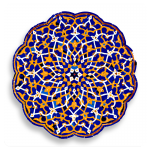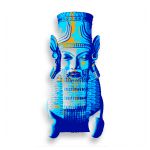There is an undeniable relationship between food and religion and tradition in every culture. For centuries, what we eat for special occasions have a symbolized significance, and Iran is no exception.
The variety of ethnicities, climates and religions in Iran, of course, comes with a variety of rituals and traditional foods.
In this short introduction, I will talk about some of these foods which are related to well-known national and religious occasions in Iran, but they are so many other examples that are limited to their regions and even many Iranians are not aware of them.
-
I) Dishes related to an Iranian (or Zoroastrian) ceremony
-
Samanu
Samanu is a sweet paste made entirely from germinated wheat (young wheatgrass), which is prepared especially for Nowruz (beginning of Spring) in a large pot and it is one of the seven symbolic elements of Haft-Seen table. This sweet paste is made not only in Iran, but in the whole cultural Iran region, Tajikistan, Afghanistan, and wherever Nowruz is celebrated.
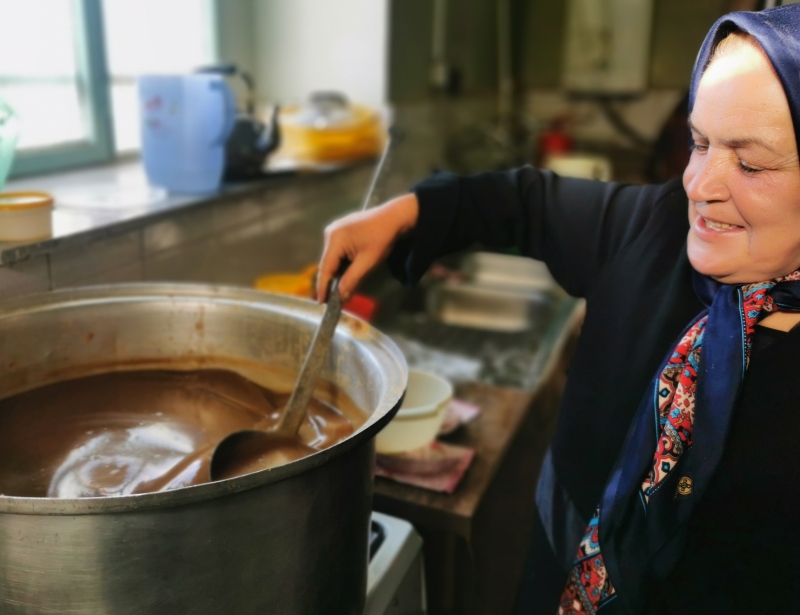
a woman making Samanu for Nowruz
-
A Green dish for the first day of Spring
The Iranian New Year coincides with the first day of spring, 21st of March. According to the Iranians’ beliefs, the first meal of this day should be something green, made of vegetables. Green in Iranian’s tradition is the color of spring and reviving the nature and the celebration of life after the long and dark winter. The common dish for this day is a mixture of rice and herb (usually coriander, dill, chives or scallions, fenugreek, and parsley), which is served with fish.
Some regions are preparing an omelet of vegetables, called Koukou Sabzi. The common point for all of these meals is the green color and the vegetables as the main ingredients.
It is interesting to know that this tradition is also respected among the Iranian Christians, and the dinner of the Christmas night as well as Easter in Iran is a dish made of vegetables, usually the herbs and rice served with fish.
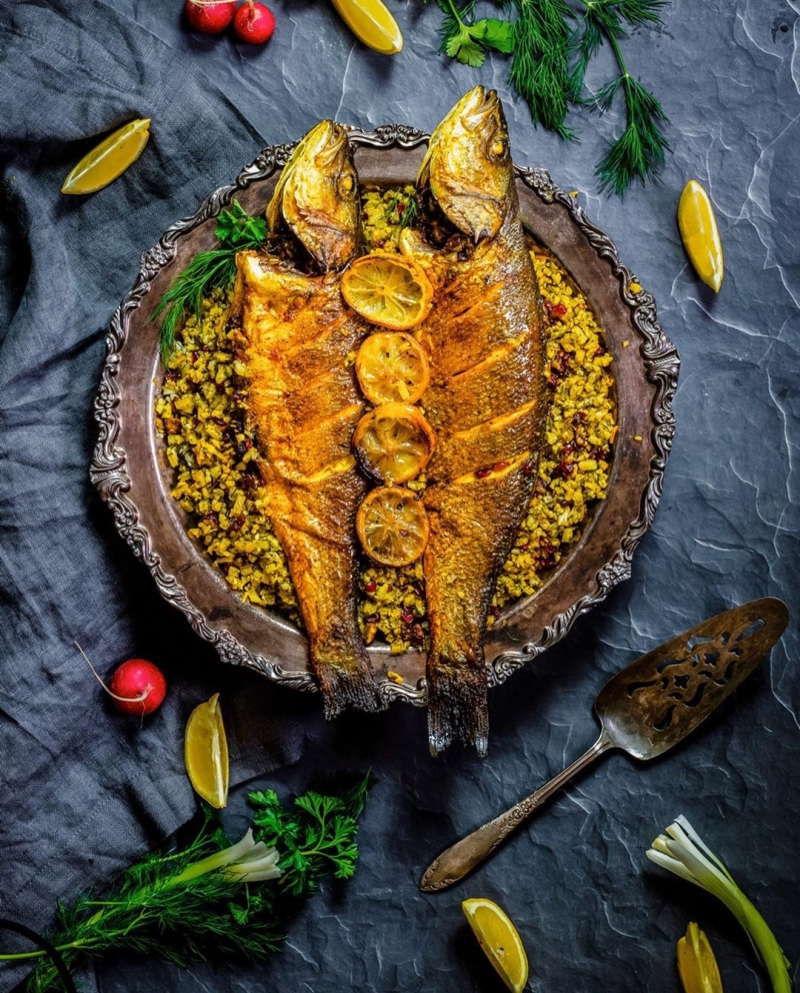
Special meal of the first day of the new year
-
Celebrating the longest night of the year (Yalda) with watermelon, pomegranate, nuts, and dried fruit
Yalda is another Iranian tradition, date backs to the centuries before the entrance of Islam in Iran. It is the celebration of light and some might relate it to the birth of Mithra. The last night of autumn, usually around the 21st of December.
This festival, still quite important and significant for all of the Iranians, regardless of their religious beliefs or ethnicity is celebrated with some special foods. Notably red fruits like the pomegranates which are the official symbol of this night and the last remaining watermelons of summer, as well as dried fruits and nuts which are the inseparable ingredients of Iranian festivals.
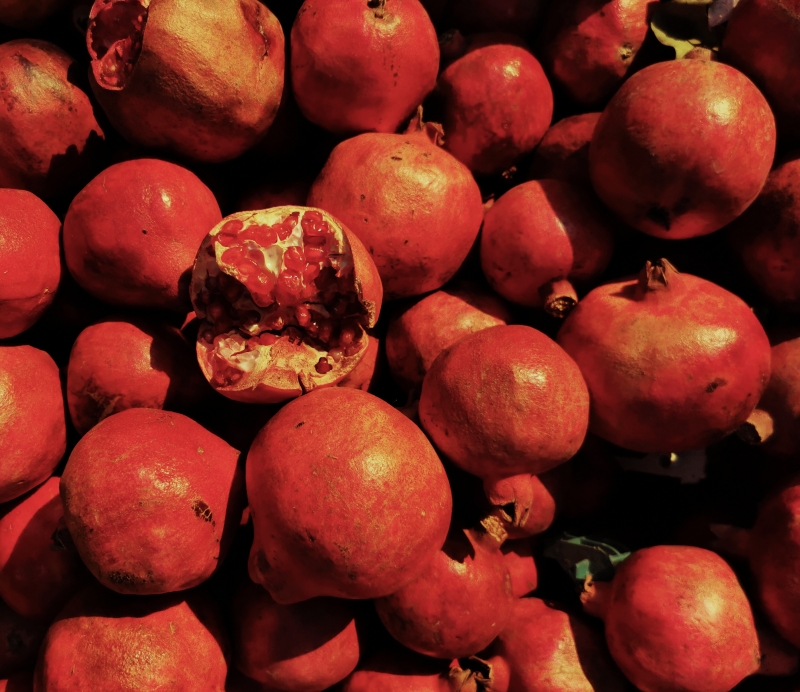
pomegranate is the special fruit of the celebration of yalda
-
Sadab (Zoroastrian ritual food)
This dish is not quite well-known, even to the Iranians. I came to know this food in my trip with a group of Zoroastrians, to see one of their religious ceremonies.
Sadab or Ruta, is a plant that is the main ingredient of this ritual dish. The vegetable is usually planted in the garden of Zoroastrians’ houses. I have also noticed it in the garden of the fire temple in Kerman.
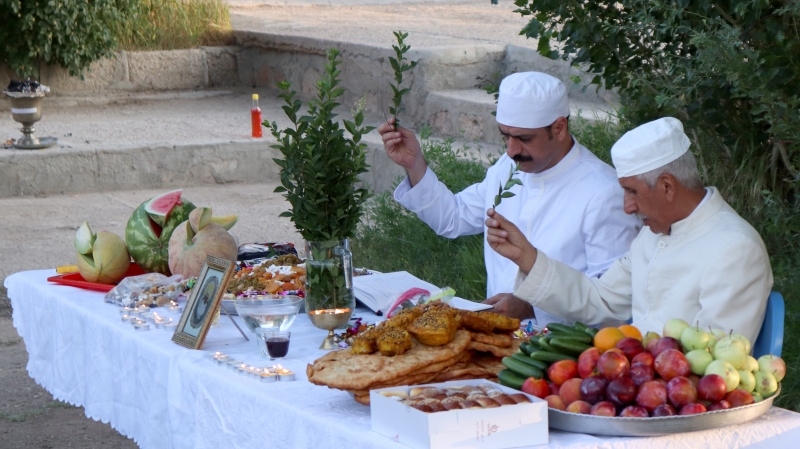
Two priests performing the ceremony
The Ruta leafs are mixed with garlic and mint, fried in the oil with turmeric, vinegar and water and served with bread. During the Zoroastrian ceremonies, specially the seasonal festivals known as Gahambars, this mixture is put in a metallic bowl in front of the priest during the ceremony. Once the ceremony is finished, one of the members of the community distributes the food among the participants.
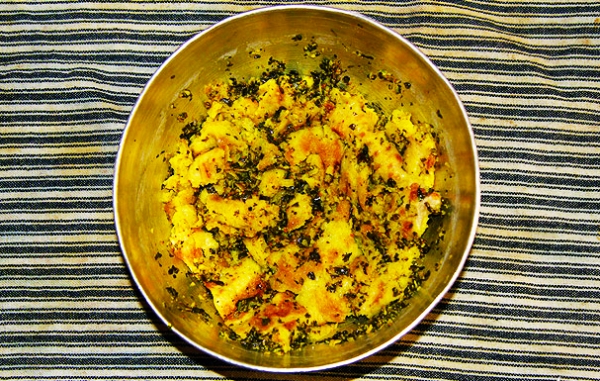
Zoroastrian ritual food
II) Dish related to a Muslim ceremony
5. Gheimeh Stew or other free foods during the month of Mourning
Iran with the majority of Shiite Muslim, has many Islamic and more precisely Shiite religious occasions. The most important Shiite ceremony, not only in Iran but for the Shiite community all over the world, is the first month of the Islamic Calendar, Muharram. During the first ten days of this month, Shiite commemorate the death of Hussein, the grandson and the 3rd successor of the Muslim’s prophet.
In Iran these ceremonies come with the tradition of Nazri, which means distributing free food to neighbors and specially to those in need. This food is considered sacred for those who make it and those who eat it, thus many believers try to participate in the process of preparing or distributing the food to be blessed.
The common meal prepared for this ceremony is Gheimeh. It is a stew made of lamb meat, split peas, potato and dried lemon, served with rice.
However, some regions have different kinds of meals, for example in the region of Kerman, the common dish is Dizi (Abgoosht), which is also a traditional dish more like a soup and made of lamb meat, potato, tomato and cereals.
In Mashhad, a holy city in northeastern Iran, the tradition meal for this sacred occasion is Sholeh, made of wheat or barley, meat and lentils.
You’ll no doubt be intrigued to learn that this tradition has opened its way into the fast food domain and in the recent years, some people are distributing Pizza, Hotdog, Burgers or fried chicken as the sacred food of these ceremonies.

A group of men cooking food for the Ashura ceremony in Yazd
III) Dishes related to important moments in life
-
Aash (a food for many occasions from falling teeth of a kid to saying farewell to a loved one)
Aash is one of those general notions in the Persian language which is not referred to as one single dish and has no specific equivalent in other languages. It is kind of a thick soup/stew, but it is neither soup nor stew, it is Aash!
This dish also has many varieties in different regions and even on different occasions. Some well-known types of Aash are, Aash-e Reshte, Aash -e barely, Aash -e Dough, Aash Shole Ghalamkar, etc.
Aash is a dish that is prepared to be shared. Even when my mother was making this dish only for the family, there were always one or two bowls going to the neighbors.
For many occasions, Aash is the best option to be shared with a large group of people. It does not need very expensive ingredients, it is vegetarian, and a huge amount of it can be made in a short time.
Sharing food should not only be for religious reasons, but there are more personal reasons as well. One of the occasions is when the first tooth of a baby starts coming out of the gum. For this occasion, the family of the baby prepares the Aash and distribute it among the family and the neighbors. They believe that by making and eating this dish, the rest of the baby’s teeth would grow more easily.
Another occasion of preparing Aash, when a member of the family goes on a trip, especially along and an important one, like immigration, pilgrimage, war, etc. It is believed that preparing this food and sharing it with others, especially the poor would bring luck and health for the traveler.
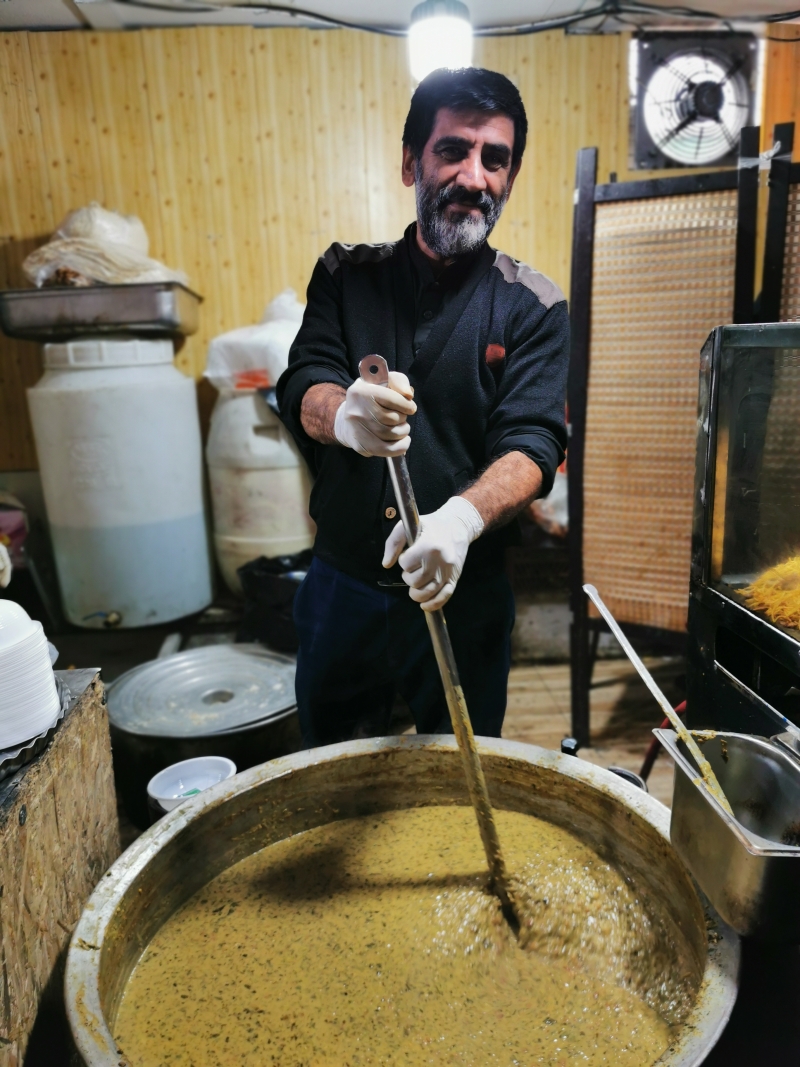
A man is preparing Aash in a weekly Friday market
-
Halva (a sweet food for bitter occasions)
Death is the life biggest mystery and comes with many traditions and customs in different cultures. Like any other culture, death is a painful event for family and friends. In Iran, the funeral ceremonies are taking very seriously and they show the respect and importance of the deceased. There is a ceremony on a funeral day, on the 3rd day after the funeral, the 7th day and the 40th day, and later the annual ceremonies.
In Iran the main food which is served to the family of the deceased or the people who are coming for the funeral and all of the mentioned ceremonies is Halva.
Halva is a dense, sweet usually made of dates, or wheat flour, sugar, and rose water. There are many explanations behind this tradition, some people believe that the date is a fruit of the tree which is always green and symbolize eternal life for the soul of the deceased. Some believe that the sweetness of Halva can help the family of the deceased feel more energized and do not faint out of sorrow and pain. Whatever is the reason, this sweet and delicious paste is one of the main funeral symbols in Iran.




